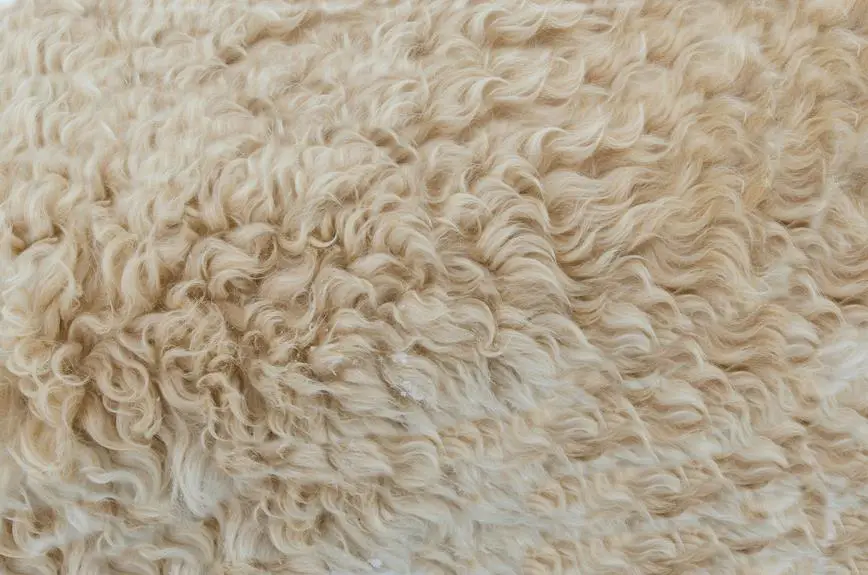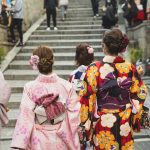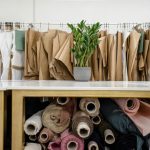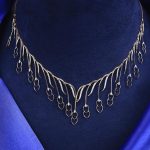When you consider the choice between brocade and velvet, you're stepping into a world of texture and style that can dramatically influence your aesthetic. Brocade's intricate patterns and structured feel may appeal to your sense of elegance, while velvet's soft touch and warmth might draw you in for a more casual vibe. Each fabric serves its purpose, but do you know how their histories and maintenance differ? Understanding these nuances can guide your decision, leading you to a conclusion that might surprise you.
Table of Contents
History of Brocade and Velvet
Brocade and velvet have rich histories that date back centuries, showcasing their evolution in textiles and fashion.
You'll find that brocade originated in ancient China, where it was woven with gold and silver threads, often reserved for royalty and the elite. Its intricate patterns and luxurious feel quickly spread to Europe during the Middle Ages, making it a staple in aristocratic wardrobes.
Velvet, on the other hand, has roots in the Middle East and became popular in Europe during the Renaissance. You might be surprised to learn that its soft texture and rich appearance made it a favorite among the wealthy, often used for clothing, upholstery, and accessories.
Both fabrics symbolize opulence, but they've also adapted over time.
As you explore their histories, you'll see how brocade became synonymous with formal wear and ceremonial robes, while velvet found its place in both casual and luxurious contexts. Each fabric tells a story of artistry and craftsmanship, reflecting the cultures that embraced them.
Whether you're drawn to the regal allure of brocade or the sumptuous feel of velvet, understanding their origins deepens your appreciation for these timeless textiles.
Texture and Feel
When you're comparing brocade and velvet, you'll notice distinct differences in texture and feel.
Brocade often feels heavier and more structured, while velvet is soft and plush against the skin.
Considering surface smoothness, weight, and breathability will help you choose the right fabric for your needs.
Surface Smoothness Comparison
You'll find that velvet typically offers a softer, plusher feel, while brocade presents a more structured and textured surface. When you run your fingers across velvet, you'll notice its luxurious, smooth texture, inviting you to touch it again and again. This plushness is perfect for creating a cozy atmosphere, making it a popular choice for upholstery and garments where comfort is key.
On the other hand, brocade's surface is less about softness and more about visual intrigue. Its intricate patterns and raised designs add depth and dimension, which can feel a bit rougher against the skin. If you're looking for something that stands out with elegance, brocade's texture can give that unique touch, but you mightn't find it as cozy as velvet.
In terms of overall smoothness, velvet clearly wins for a gentle touch, whereas brocade excels in providing a rich, textured experience. So, if you're after comfort and a soft feel, velvet's the way to go. But if you're leaning towards a statement piece with visual appeal, brocade's structured surface will certainly catch your eye.
Weight and Thickness
Comparing weight and thickness, velvet tends to be lighter and thicker, giving it a plush, cozy feel, while brocade is generally heavier and more structured, adding a sense of opulence to any fabric choice.
When you touch velvet, you'll notice how it envelops you with its soft, warm texture. This thickness contributes to its luxurious appeal, making it a popular choice for upholstery and evening wear.
On the other hand, brocade's weight gives it a more formal demeanor. The intricate patterns woven into the fabric require a sturdier base, which results in a heavier drape. When you handle brocade, you can feel the density, and it holds its shape well, making it ideal for elegant garments and home décor items that need to stand out.
Ultimately, your choice between velvet and brocade may depend on the look and feel you're aiming for in your project. If you're after a soft, inviting atmosphere, velvet's thickness is perfect.
But if you want something that exudes sophistication and structure, brocade will deliver that opulent touch you desire.
Breathability and Warmth
Breathability and warmth are key characteristics that distinguish velvet from brocade. Velvet offers a softer, more breathable fabric ideal for cooler climates, while brocade provides a heavier warmth that can sometimes feel stifling.
If you're looking for something comfortable to wear during chilly evenings, velvet's lightweight nature allows for better air circulation, preventing you from overheating. You'll appreciate how it drapes softly against your skin, enhancing your overall comfort.
On the other hand, brocade's rich, ornate texture comes with a denser weave that traps heat effectively. This makes it perfect for formal settings or winter events where you want to stay warm. However, keep in mind that its lack of breathability can lead to discomfort in warmer environments.
If you choose brocade, be prepared for a more structured feel, which mightn't offer the same level of softness as velvet.
Ultimately, your choice will depend on the occasion and climate. If you prioritize comfort and breathability, velvet's your best bet. But if you need something warm and luxurious, brocade could be the right fabric for you.
Common Uses
When you think about common uses for brocade and velvet, you'll notice they shine in different areas.
Brocade often enhances home décor with its luxurious patterns, while velvet is a go-to choice in the fashion industry for its rich texture.
Understanding these applications can help you choose the right fabric for your needs.
Home Décor Applications
Incorporating brocade or velvet into your home décor can instantly elevate the aesthetic, adding texture and richness to any space. These luxurious fabrics not only offer visual appeal but also enhance the tactile experience of your environment.
Here are three common applications to consider:
- Cushions and Throw Pillows: Adding brocade or velvet cushions can create a cozy, inviting atmosphere. Their plush texture invites you to sink in and relax, making them perfect for living rooms or bedrooms.
- Drapery and Curtains: Using brocade or velvet for window treatments can dramatically transform a room. The way sunlight filters through these fabrics can create stunning visual effects, while also providing an added layer of insulation.
- Upholstered Furniture: Choosing brocade or velvet for upholstery can turn ordinary pieces into statement furniture. Whether it's a chair, sofa, or ottoman, these fabrics bring elegance and sophistication, making them focal points in any room.
Fashion Industry Preferences
Brocade and velvet often steal the spotlight in high fashion, lending an air of opulence and sophistication to garments and accessories. You'll find these luxurious fabrics gracing everything from runway collections to red carpet events. Designers often choose brocade for structured pieces, while velvet is favored for its soft drape and rich texture.
Here's a quick comparison of their fashion industry preferences:
| Fabric | Common Uses |
|---|---|
| Brocade | Evening gowns, structured blazers, statement accessories |
| Velvet | Dresses, suits, casual wear, upholstery in fashion shows |
When you're deciding between the two, consider the occasion. Brocade shines in formal settings, where its intricate patterns can truly stand out. Velvet, on the other hand, offers versatility, transitioning easily from day to night.
Both fabrics have their place in your wardrobe, so you can easily mix and match them for different looks. Whether you choose brocade's grandeur or velvet's charm, you'll elevate your style effortlessly.
Care and Maintenance
To keep both brocade and velvet looking their best, you should regularly dust them and avoid direct sunlight to prevent fading. Proper care and maintenance can extend the life of these luxurious fabrics, ensuring they remain vibrant and beautiful for years to come.
Here are three essential tips to maintain your brocade and velvet:
- Gentle Cleaning: Use a soft brush or lint roller to gently remove dust and debris. For deeper cleaning, consider a professional dry cleaner, especially for brocade, which can be sensitive to moisture.
- Storage Solutions: When storing your items, opt for breathable garment bags or cotton sheets. Avoid plastic covers, as they can trap moisture and lead to mold or mildew.
- Spot Treatment: For any stains, act quickly. Blot the area with a clean, dry cloth, and apply a mild fabric cleaner specifically designed for the type of fabric. Always test in an inconspicuous area first to ensure it doesn't damage the material.
Cost Comparison
When comparing costs, you'll find that velvet tends to be more affordable than brocade, which often carries a premium price due to its intricate designs and rich history.
If you're on a budget, velvet can be a great option, as it's widely available and comes in various qualities and textures that suit different price ranges. You can easily find decent-quality velvet without breaking the bank.
On the other hand, brocade is typically made from silk or a silk blend, which adds to its cost. The complex weaving process and decorative patterns require more craftsmanship, further driving up the price. If you're looking for something luxurious and unique, you might consider investing in brocade, but be prepared for a higher financial commitment.
When planning your project or purchase, it's essential to factor in not just the initial costs but also the longevity and durability of each fabric. Velvet might save you money upfront, but if you prefer a fabric that stands out and lasts longer, brocade could be worth the extra expense.
Ultimately, weighing your budget against your design aspirations will help you make the best decision.
Choosing the Right Fabric
Deciding between brocade and velvet hinges on your specific project needs and aesthetic preferences. Each fabric brings its unique charm, but you'll want to consider a few key factors before making your choice.
- Texture and Feel: Brocade features a raised pattern that adds depth and richness, making it perfect for formal events. Velvet, on the other hand, offers a soft, plush feel that evokes comfort and luxury.
- Durability and Maintenance: Brocade's sturdy weave makes it more resistant to wear and tear, ideal for upholstery or heavy drapery. Velvet is more delicate and may require careful cleaning, but its sumptuous appearance can elevate your space.
- Color and Patterns: Brocade often comes in intricate designs and rich colors, perfect for a traditional or opulent look. Velvet, available in a wider range of solid colors, can easily blend with modern or minimalist aesthetics.
Frequently Asked Questions
Can Brocade and Velvet Be Mixed in a Single Design?
Yes, you can mix brocade and velvet in a single design. Their rich textures and colors can create a stunning visual contrast, adding depth and elegance to your space. Just balance their proportions for harmony.
What Are the Environmental Impacts of Brocade and Velvet Production?
When considering the environmental impacts of fabric production, you'll find both brocade and velvet can involve high resource use, water consumption, and chemical treatments, contributing to pollution and ecological harm throughout their manufacturing processes.
Are There Hypoallergenic Options for Brocade and Velvet Fabrics?
Yes, there are hypoallergenic options available for both brocade and velvet fabrics. You can find alternatives made from synthetic fibers or organic materials, which reduce allergens and provide a comfortable experience without sacrificing style.
How Do Brocade and Velvet Perform in Different Climates?
When considering different climates, brocade tends to retain heat, making it ideal for colder environments. Velvet, however, breathes better, offering comfort in warmer weather. Choose based on your local climate's needs for optimal wear.
What Are the Best Color Combinations for Brocade and Velvet?
When choosing color combinations, consider pairing rich jewel tones like emerald with gold for a luxurious feel. Alternatively, soft pastels work beautifully together, creating an elegant and serene atmosphere. Trust your instincts to find what resonates!
- Never Buy Too Little: How Much Fabric for Two Standard Pillow Cases - June 25, 2025
- Fabric Requirements for a Body Pillow Case: A Complete Guide - June 25, 2025
- How Much Fabric Do I Need to Make a Standard Pillow Case? - June 25, 2025







